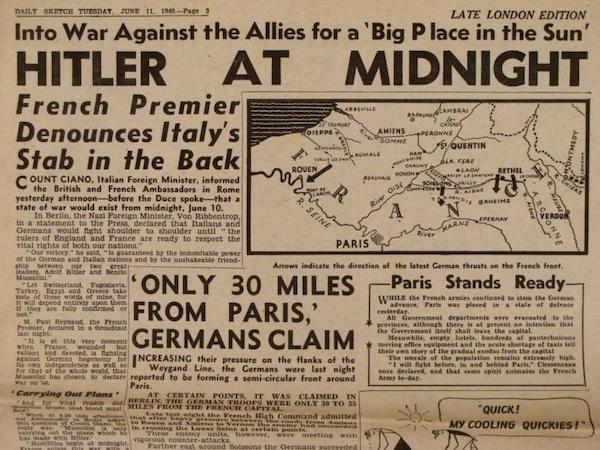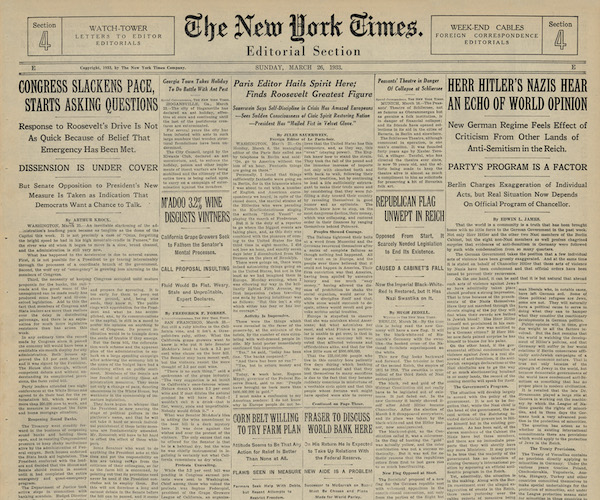Imagine you check your mailbox to find a neatly folded copy of The New York Times waiting for you, its headline reading, “Herr Hitler’s Nazis Hear an Echo of World Opinion.” Wait. What? A double-take ensues as you encounter Susan Silton’s most recent work of art. As part of a trilogy of artworks created in response to the political realities in America since 2016, this singular piece creates and captures reflective thought, reinforced by its elliptically cryptic title: A potentiality long after its actuality has become a thing of the past. Taken from a quote from Hannah Arendt’s famous but widely misinterpreted text, Eichmann in Jerusalem: A Report on the Banality of Evil, the work’s title articulates how actions in the past stay with us as eternal recurrences, potentially forever. As a kind of visual accompaniment to Arendt’s controversial exploration into the minds and actions that led to the Holocaust, Silton’s work enacts the interruption necessary to suspend, if only for a moment, the non-thinking and routine compliance, and lack of questioning that evil requires of its subjects to enact its horrific job.

Page 3 of the “Daily Sketch,” June 11, 1940.
Awhile back in 2018, Silton came across a cache of American newspapers for sale from the 1930s and early ’40s, their headlines reporting on Hitler and the Third Reich. Silton purchased the papers and recreated five as indigo digital prints. Additionally, she selected photos from her personal archive with the intention of displaying them alongside the newspapers in the event the work ever finds a suitable exhibition venue. On their own, Silton’s photos of things like a dead possum or a swingset seem unremarkable, were they not accompanied by the ominous newspapers nearby; the juxtaposition underscores the connection between subjective looking and objective reportage.
Silton has mailed, and sometimes delivered face-to-face, her newspaper facsimiles to an ever-growing list of journalists, activists, artists, politicians and other individuals. Over 500 recipients will receive the work, bringing to mind a grassroots direct mail campaign that uses the shock of the past to heighten the emergency of the present. As artistic messaging it’s quite effective.
Each newspaper arrives in a clear cellophane wrapper, ensuring that as it passes through the U.S. Postal Service; every person it encounters becomes a potential viewer, sees the front pages of the papers, and reads headlines like, “German Fugitives Tell of Atrocities at Hands of Nazis.” But upon receiving the work what is one to do with it? Keeping it unopened and storing it away would allow the headlines to linger, ready to re-emerge with time, with the archival impulse implying the untouched artworks might be worth more than their opened and handled counterparts. Or does one open Silton’s unexpected parcel and read the work like any other paper? Would this read even be possible? Would doing so impact how one reads or ignores today’s breaking news? What about framing the newspapers and displaying them as “art,” inevitably altering the latent political urgency of any “art” nearby. In this way, Silton’s work is productively infectious and implicitly interrogative—it heightens one’s decisions and actions and their possible ramifications. How you react when the wreckage of the past lingers in your complicity with, or resistance to, atrocities today.
In speaking with Silton about the work, I struggle to explain the dislocated feelings of familiarity her newspapers conjure. I’m struck by how the headlines echo and rhyme with current events, not just the ones about the rise of fascism, but others that report on the day-to-day workings of the American government, like Republicans and Democrats debating on spending and taxes. Silton replies, “It almost is uncanny to read these headlines years later and see them embedded in this particular form. It seems similar for me at least.
This is how history repeats in fundamental ways. This is how we lose sight while we are living in it …like frogs in a slow-boiling pot.”


